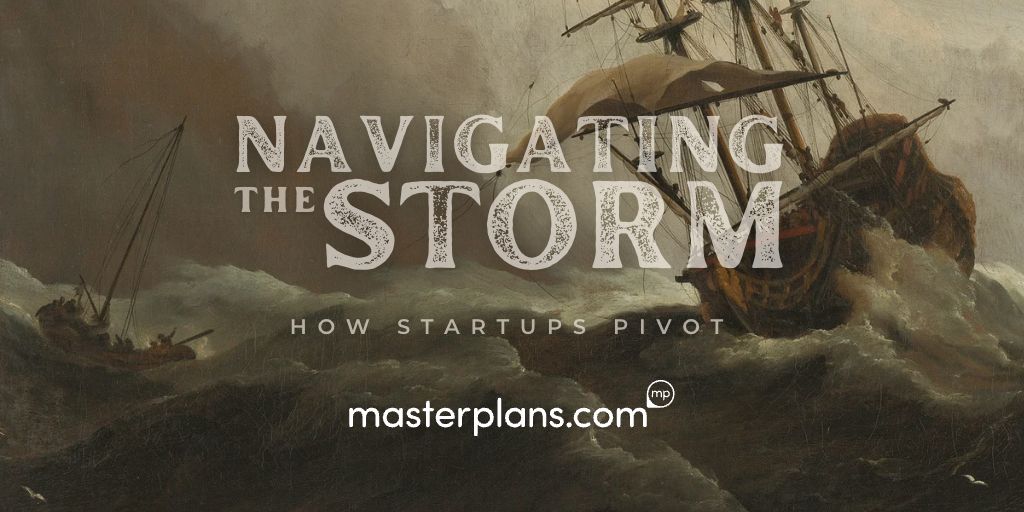How to Write a Management Summary for Your Business Plan
Entrepreneurs are often celebrated for their uncanny ability to understand others – their customers, the market, and the ever-evolving global...
6 min read
![]() Ben Worsley
Apr 20, 2023 8:57:42 AM
Ben Worsley
Apr 20, 2023 8:57:42 AM

A few weeks ago, I wrote an article discussing how the current economic climate and the possibility of a recession hasn’t deterred recent Masterplans clients. At least, not yet.
That does not mean that our clients want a recession to occur; no business owner is excited about the limited access to capital and decreased consumer spending that accompany a recession.
Nor is it because our customers have their collective heads buried in the sand. (Far from it. Our clients are really smart.)
Rather, it’s because entrepreneurs think differently than the rest of us; they are inherently risk-takers who look to the world around them to find ways to adapt and thrive. Rather than attempting to launch "recession-proof" businesses, our clients are sticking with their innovative ideas and focusing on how to adapt them through uncertain economic conditions.
The term we often use in the entrepreneurship space for a strategic change in a company’s business model, product, or target market is the “pivot.” One of the best parts of working at the planning stage is that startups are more agile and flexible than established businesses, and today I wanted to look at the different types of pivots a company can take, and show some real-life examples of some companies that have done it effectively.
It goes without saying that customers are the lifeblood of any business. However, customer needs are always changing, and this is especially true during an economic downturn. Competition for consumers' discretionary spending changes in a recession, which can be bad news for businesses that rely on consumer spending. Customers start forgoing luxury purchases like their daily iced coffee in favor of cheaper options like making their own drip coffee at home.
REal-World Example: GrouponIn 2007, Groupon was founded as The Point, a service that sought to harness collective power to achieve a common goal. The concept didn't gain traction until it recognized the common cause of saving customers money, and they pivoted to Groupon in 2008. The timing was fortunate, and the company was able to capitalize on assisting both customers and businesses during a period of low discretionary spending. In just 18 months, Groupon grew to 350 employees and became the fastest company to reach a $1 billion valuation. Not bad for a pivot, right? Source: Wikipedia |
We often think of startups as companies that develop new technologies, and according to my Medium feed, some company called OpenAI could be on the verge of something big. (I’ll return to this later, I promise.) However, successful startups aren't just good at developing new technologies; they're also good at being among the first to implement and benefit from them. In doing so, the startup may be able to cut costs and offer their products or services at a lower price. Of course, in an article like this, I'd be remiss if I didn't mention Large Language Models (LLMs) like ChatGPT (remember what I promised?). It's the cutting edge of technology right now, and every new business should think about how AI can make their processes more efficient.
REal-World Example: InstagramInstagram began in 2010 as Burbn, a mobile check-in app. It didn't take long for the company's founders to realize that their app had two major flaws: first, it was too similar to its primary competitor, Foursquare (shout out to all you mayors out there); and second, the app's few users were more interested in the photo-sharing feature than anything else it offered. The company shifted its focus (sorry about that) to utilizing new technologies for file sharing and more robust features, such as filters. Instagram was acquired by Facebook in 2012 for $300 million (plus a bunch of stock) and currently has 1.3 billion monthly average users (MAUs). Source: Wikipedia |
Modern startups don’t just offer innovative products; they also innovate in the methods they use to sell them. Indeed, an increasing number of businesses are combining multiple business models; for example, few brick-and-mortar retailers open anymore without an online store. While numerous revenue models exist, the reigning champion in today's market is the subscription model. That's why the majority of the software industry has shifted to a monthly fee model for distribution rather than relying on physical media (remember when people were aghast when Apple started making laptops without disk drives?). Today, companies like Quip and Dollar Shave Club are better recognized for their recurring subscription model than for their toothbrush and razor blade products. When executed effectively, subscription models not only reward loyal customers but also generate consistent revenue. By integrating a secondary loss leader pricing strategy (AKA the classic razors and blades model) Dollar Shave Club boosted its customer base and created a powerful combination that propelled growth. This fusion of business models helps the company maintain its competitive edge while continuing to attract and retain customers.
REal-World Example: NetflixNetflix just announced that it will discontinue its DVD-by-mail service, 25 years after it was first introduced. The initial business model was a per-rental model, similar to existing video stores at the time, but with the added convenience of having it delivered to your home. However, the announcement that Netflix would offer a monthly subscription with no due dates, late fees, or shipping fees proved to be a game-changer for the company. By 2005, Netflix was mailing 1 million DVDs per day. It's worth noting that Netflix, which launched its streaming service in 2008 in response to rising internet access and speed, could also serve as an example for the "adopting new technology" pivot mentioned above. Source: Wikipedia |
Regardless of what you've read about Bud Light, embracing sustainability and inclusivity is a great way for businesses to attract new (particularly younger) customers. There may be some initial pushback, but history shows that it usually has a positive net effect. After all, Bud Light has garnered more media attention in the last two weeks than it has in years. The relentless pursuit of year-over-year profit growth can lead companies to make decisions that benefit the bottom line in the short term but have negative long-term consequences because they exploit the environment or workers. According to recent research by MIT Sloan School of Business, focusing on corporate social responsibility (CSR) makes businesses more resilient in the face of economic downturns. But remember, committing to CSR should be more than just using the latest buzzwords.
Real-World Example: PatagoniaIn his influential business book Let My People Go Surfing, Patagonia founder Yvon Chouinard stated, “Despite the challenges involved, we’ve found that every time we’ve elected to do the right thing, even when it costs twice as much, it’s turned out to be more profitable.” By advocating for environmental and social responsibility, Patagonia has built and sustained a solid customer base. Of course, there have been times when these decisions have hurt the company's bottom line; for instance, Patagonia has stuck to its promise to use long-lasting materials, even if that has meant fewer product sales. Patagonia has grown its business organically rather than focusing on short-term gains. Patagonia now earns around $100 million annually and has transitioned into a trust specifically created to combat climate change. Source: Let My People Go Surfing |
Sure, the business world is competitive, but exploring how you can collaborate with other companies who share your mission or target market is a great way to reduce expenses, find new customers, and gain new perspectives. Examples of strategic partnerships might include cross-promotions and referrals with affiliate fees, bundled or co-branded products, or resource-sharing for staff or technology. A common way companies are partnering today is in marketing. Creating blog posts or podcasts across two businesses can increase domain authority; likewise, doing webinars with multiple businesses as a host can increase the audience reach and be more beneficial to your target customer. While the internet makes finding potential partners easier than ever, always make sure you are partnering with businesses who share core goals and values.
Real-World Example: Barnes & Noble and StarbucksNew books and the scent of freshly brewed coffee seem to go hand in hand these days. But that wasn't always the case. In 1993, Barnes & Noble realized that putting a cafe in their stores would be a great way to turn their bookstores into community hubs and gain an edge over online retailers like Amazon. Barnes & Noble saw an increase in customers by collaborating with a well-known company like Starbucks, particularly in the morning hours when customers are less likely to buy books, and Starbucks was able to open new locations with lower operating costs. Source: PwC |
While the aforementioned cases show what can happen when a pivot succeeds, there are countless other examples of failed pivots. While any change in strategy carries some risk, there are some things businesses can do to help manage the transition.
It's called a “pivot” because it's important for a business to stay connected to what it does well already. Before you start focusing on the problems (see the next tip), start by making a list of strengths. This can provide a solid foundation for your change in strategy.
We've said it before: entrepreneurs are problem solvers. A successful pivot, however, is never change for the sake of change; it must first address the challenges that the company (or, more importantly, the customer) is facing. Even if the issues appear obvious, writing them down can help you see connections that your pivot can solve.
Small businesses and startups benefit greatly from being agile and adaptable. However, you should not rush things for fear of losing your current clientele or undoing your progress so far. Before fully-committing to a pivot, can you dip your toe in with a minimum viable product (MVP), possibly even getting feedback from existing customers? You must constantly monitor the progress of a pivot and remember to test and iterate. A successful pivot is frequently the result of lessons learned from previous failed attempts.
When economic conditions shift, a company's ability to pivot quickly and efficiently can determine whether or not it survives and thrives. The key to a company's survival is learning from the past, listening to the market, and planning for the future.

Entrepreneurs are often celebrated for their uncanny ability to understand others – their customers, the market, and the ever-evolving global...

Despite growth in sectors like artificial intelligence, venture capital funding has seen better days. After peaking at $347.5 billion in 2021, there...

Most people think of a professional business plan company primarily as a "business plan writer." However, here at Masterplans, we choose to approach...